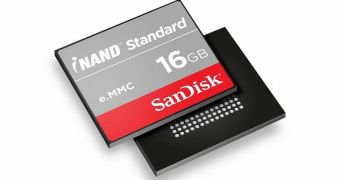Normal NAND Flash chips are all well and good when you're only looking for something to make a flash drive or SSD out of, but the same can't be said about the NAND set to be used in tablets and smartphones.
For that reason, SanDisk has formally launched the iNAND Standard embedded flash drive (EFD), which it describes as “an ideal storage solution for entry-level tablets and smartphones.” SanDisk intends for it to sell in China most of all, but also other “high-growth markets.”
The chip is a 1 nanometer 3-bit-per-cell (X3) NAND flash storage solution, and the fourth e.MMC storage device that SanDisk has based on the X3 flash memory so far.
It should be simple enough to use the iNAND instead of whatever solid-state memory current-generation phones and tablets employ.
That's what SanDisk wanted: for prospective buyers to have no trouble installing the flash in existing products. Backwards compatibility as it were.
Anyway, the new iNAND chip is e.MMC 4.51+HS2.00 compliant and uses SanDisk's “industry-leading 1Y nanometer (nm) process technology.”
The sequential read and write speeds are up to 100 MB/s and 7.5 MB/s, respectively, while random read/write performance is of 3000 / 200 IOPS.
Sales should start in 8 GB and 16 GB capacities in the second half of the year, so maybe as early as July 2014.

 14 DAY TRIAL //
14 DAY TRIAL //